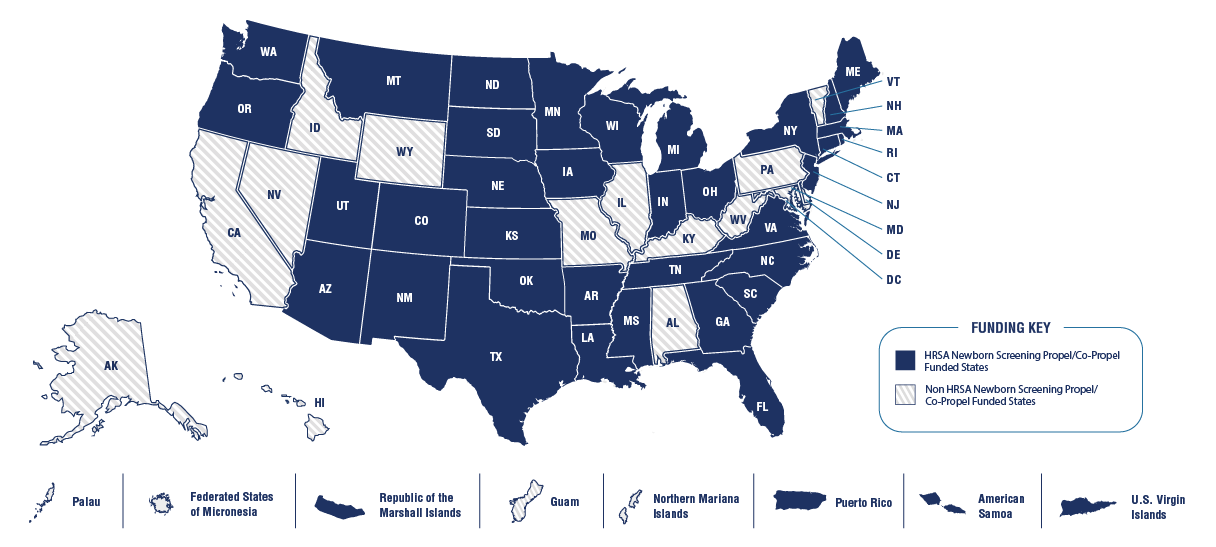This program builds on the Newborn Screening (NBS) Propel program to ensure all babies receive better screening and care.
It shares the same goals as the NBS Propel program, but it allows states to partner as a region to apply for funding. Awardees also do not have to be a state agency, and they can form partnerships with organizations that serve newborn screening programs.
Awards
We awarded $3.4 million in 2024 to seven states.
- Read the closed funding opportunity notice (HRSA-24-052) for details.
- This funding adds to the 2023 NBS Propel funding for 28 states and U.S.-affiliated jurisdictions.
Our reach
This program expands the reach of the NBS Propel Program. It supports 35 states and 4 U.S.-affiliated jurisdictions (Republic of Marshall Islands, Puerto Rico, American Samoa, and the U.S. Virgin Islands).
Newborn Screening Propel and Co-Propel Program Reach

Map description
Map of the United States showing HRSA Newborn Screening Propel and Co-Propel program reach.
HRSA Newborn Screening Propel/Co-Propel funded states/territories: American Samoa, Arizona, Arkansas, Colorado, Connecticut, Florida, Georgia, Indiana, Iowa, Kansas, Louisiana, Mane, Massachusetts, Michigan, Minnesota, Mississippi, Montana, Nebraska, New Hampshire, New Jersey, New Mexico, New York, North Carolina, North Dakota, Ohio, Oklahoma, Oregon, Puerto Rico, Republic of the Marshall Islands, Rhode Island, South Carolina, South Dakota, Tennessee, Texas, Utah, U S Virgin Islands, Virginia, Washington, and Wisconsin.
Non HRSA Newborn Screening Propel/Co-Propel funded states/territories: Alabama, Alaska, California, Delaware, District of Colombia, Federated States of Micronesia, Guam, Hawaii, Idaho, Illinois, Kentucky, Maryland, Missouri, Nevada, Northern Mariana Islands, Palau, Pennsylvania, Vermont, West Virginia, and Wyoming.
How the NBS Co-Propel program works
This program builds on the NBS Propel program. Some awardees form partnerships to support multiple state programs. This approach fosters teamwork and new ideas so they can continue to:
- Address their specific challenges
- Ensure timely data collection and reporting
- Support long-term follow-up for individuals with Severe Combined Immunodeficiency (SCID) and other NBS conditions
Read more about how this effort aims to fix gaps and create effective screening systems at How NBS Propel works.
Co-Propel objectives
By June 2028, awardees must:
- Develop a data collection plan together with our newborn screening technical assistance center, NewSTEPs. This plan must measure the percentage of 3-year-old children with at least one heritable condition (condition passed from a parent through genes) found and treated through newborn screening and who are now thriving.
- Track and report on at least one long-term, follow-up measure for a heritable condition found through newborn blood spot screening.
In support of the Blueprint for Change
Newborn screening programs are vital for improving the health of babies and children.
By investing in these state programs, this work supports the national Blueprint for Change for Children and Youth with Special Health Care Needs. This program fills critical gaps and makes state programs more effective. This way, every family can get what their child needs so that they can play, go to school, and grow up to become a healthy adult.
More information
News & events
Stay up-to-date with MCHB: sign up for newsletters.
Jobs
Find open positions with HRSA.
Contact us
Need more information, or have a specific question about this program? Contact us at NBSprograms@hrsa.gov.
Want to understand more about newborn screening? Visit the Newborn Screening Information Center for information on health conditions, the process, and your state’s program.